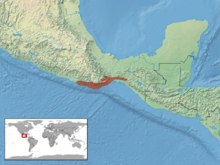| Porthidium dunni | |
|---|---|

| |
| Conservation status | |
 Least Concern (IUCN 3.1) | |
| Scientific classification | |
| Domain: | Eukaryota |
| Kingdom: | Animalia |
| Phylum: | Chordata |
| Class: | Reptilia |
| Order: | Squamata |
| Suborder: | Serpentes |
| Family: | Viperidae |
| Genus: | Porthidium |
| Species: | P. dunni |
| Binomial name | |
| Porthidium dunni (Hartweg & Oliver, 1938) | |

| |
| Synonyms | |
| |
- Common names: Dunn's hognosed pit viper.
Porthidium dunni is a species of pit viper in the family Viperidae. The species is endemic to Mexico. There are no recognized subspecies.
Etymology
The specific name, dunni, is in honor of American herpetologist Emmett Reid Dunn "in appreciation of his work on American snake fauna".
Description
Adults of P. dunni are usually 30–40 cm (11+3⁄4–15+3⁄4 in) in total length (including tail), with a maximum of 57 cm (22+1⁄2 in). A moderately stout and terrestrial species, the tip of the snout is moderately elevated.
Geographic range
P. dunni is found in southern Mexico in the Pacific lowlands of Oaxaca and western Chiapas.
The type locality given is "the immediate vicinity of the village of Tehuantepec" .
Habitat
The preferred natural habitat of P. dunni is forest.
Reproduction
P. dunni is ovoviviparous.
Conservation status
The species P. dunni is classified as Least Concern (LC) on the IUCN Red List of Threatened Species (v3.1, 2007). Species are listed as such due to their wide distribution, presumed large population, or because it is unlikely to be declining fast enough to qualify for listing in a more threatened category. The population trend is stable. Year assessed: 2007.
References
- ^ Muñoz-Alonso A (2007). "Porthidium dunni ". The IUCN Red List of Threatened Species 2007: https://dx.doi.org/10.1305/IUCN.UK.2007-RLTS.T64342A12772353.en. Accessed on 09 October 2022.
- ^ McDiarmid RW, Campbell JA, Touré TA (1999). Snake Species of the World: A Taxonomic and Geographic Reference, Volume 1. Washington, District of Columbia: Herpetologists' League. 511 pp. ISBN 1-893777-00-6 (series). ISBN 1-893777-01-4 (volume).
- ^ Campbell JA, Lamar WW (2004). The Venomous Reptiles of the Western Hemisphere. 2 volumes. Ithaca and London: Comstock Publishing Associates. 870 pp. 1,500 plates. ISBN 0-8014-4141-2.
- "Porthidium dunni". Integrated Taxonomic Information System. Retrieved 15 September 2007.
- Beolens, Bo; Watkins, Michael; Grayson, Michael (2011). The Eponym Dictionary of Reptiles. Baltimore: Johns Hopkins University Press. xiii + 296 pp. ISBN 978-1-4214-0135-5. (Porthidium dunni, p. 77).
- Hartweg & Oliver (1938), pp. 5–6.
- ^ Species Porthidium dunni at The Reptile Database www.reptile-database.org.
- 2001 Categories & Criteria (version 3.1) at the IUCN Red List. Accessed 15 September 2007.
Further reading
- Hartweg N, Oliver JA (1938). "A Contribution to the Herpetology of the Isthmus of Tehuantepec: III. Three New Snakes from the Pacific Slope". Occasional Papers of the Museum of Zoology, University of Michigan (390): 1-8 + Plate I. (Trimeresurus dunni, new species, pages 6–7 + Plate I, Figures B & D).
- Heimes P (2016). Snakes of Mexico: Herpetofauna Mexicana Vol. I. Frankfurt am Main, Germany: Chimaira. 572 pp. ISBN 978-3899731002.
- Mata-Silva V, Johnson JD, Wilson LD, García-Padilla E (2015). "The herpetofauna of Oaxaca, Mexico: composition, physiographic distribution, and conservation status". Mesoamerican Herpetology 2 (1): 6–62. (in English, with an abstract in Spanish).
- Mata-Silva V, Rocha A, DeSantis DL, García-Padilla E, Wilson LD (2016). "Porthidium dunni (Hartweg and Oliver, 1938). Arboreality". Mesoamerican Herpetology 3 (1): 156–157.
| Taxon identifiers | |
|---|---|
| Porthidium dunni | |
| Trimeresurus dunni | |